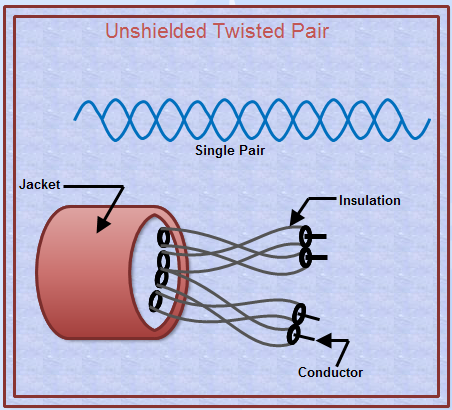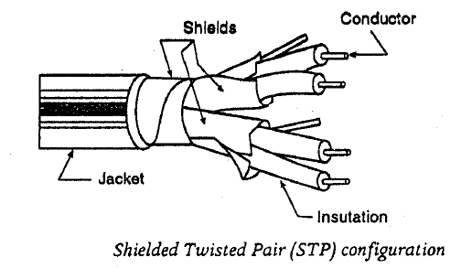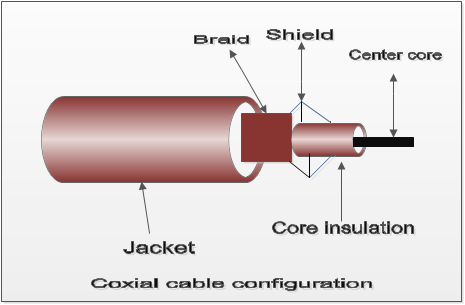Bound Transmission Media in Communication Networks are the cables that are tangible or have physical existence and are limited by the physical geography. Also known as Conducted systems, wired media generally employ a metallic or glass conductor which serves to conduct, some form of electromagnetic energy.
Popular bound transmission media in use are twisted pair cable, co-axial cable and fiber optical cable.
Fiber optic systems conduct light or optical energy, generally using a glass conductor. The term bounded or guided media refers to the fact that the signal is contained within an enclosed physical path. Finally, bounded media refers to the fact that some form of shield, cladding, and/or insulation is employed to bind the signal within the core medium, thereby improving signal strength over a distance and enhancing the performance of the transmission system in the process. Twisted pair (both unshielded and shielded), coaxial and fiber optic cable systems fall into this category.
We’ll be covering the following topics in this tutorial:
Twisted Pair (Copper Conductors)
A twisted pair is a pair of copper wires, with diameters of 0.4-0.8 mm, twisted together and wrapped with a plastic coating. The twisting reduces the electrical noise and the error rate of the data transmission. Each conductor is separately insulated by some low-smoke and fires retardant substance. Polyethylene, polyvinyl chloride, flouro polymer resin and Teflon(r) are some of the substances that are used for insulation purposes.  Twisting process serves to improve the performance of the medium by containing the electromagnetic field within the pair. Thereby, the radiation of electromagnetic energy is reduced and the strength of the signal within the wire is improved over a distance. This reduction of radiated energy also serves to minimize the impact on adjacent pairs in a multiple cable configuration. This is especially important in high-bandwidth applications as higher frequency signals tend to lose power more rapidly over distance. Additionally, the radiated electromagnetic field tends to be greater at higher frequencies, impacting adjacent pairs to a greater extent. Generally, the more the twists per foot, the better the performance of the wire.
Twisting process serves to improve the performance of the medium by containing the electromagnetic field within the pair. Thereby, the radiation of electromagnetic energy is reduced and the strength of the signal within the wire is improved over a distance. This reduction of radiated energy also serves to minimize the impact on adjacent pairs in a multiple cable configuration. This is especially important in high-bandwidth applications as higher frequency signals tend to lose power more rapidly over distance. Additionally, the radiated electromagnetic field tends to be greater at higher frequencies, impacting adjacent pairs to a greater extent. Generally, the more the twists per foot, the better the performance of the wire.
These are popular for telephone network. The energy flow is in guided media. Metallic wires were used almost exclusively in telecommunication networks for the last 80 years, until the development of microwave and satellite radio communications systems. Therefore, copper wire is now a mature technology, rugged and inexpensive. In certain applications, copper-covered steel, copper alloy, nickel- and/(or) gold-plated copper and even aluminum metallic conductors are employed.
The maximum transmission speed is limited in this case. The copper conductor that carries analog data can be used to carry digital data also in association with modem. Modem is a device to convert digital signal into analog signal and vice versa. The data rate in this category is limited to around 28 Kbps. The introduction of the Integrated Services Digital Network (ISDN) led to the use of improved modulation and coding schemes and data rate up to 128 Kbps. Local Area Networks (LANs) also use twisted pairs. These networks also upgraded to support for high bit rate real time multimedia. A recent development is Asymmetric Digital Subscriber Lines (ADSL) technology which is aimed at using two wire copper loops at data rates of 1.544Mbps in the network to user direction and about 600 Kbps from the user to network.
The twisted pair cable may be defined in two categories based upon the shielding and without shielding.
Unshielded Twisted Pair (UTP) UTP as depicted in Figure is the copper media, inherited from telephony, which is being used for increasingly higher data rates, and is rapidly becoming the de facto standard for horizontal wiring. Horizontal wiring specifies the connection between, and including, the outlet and the termination in the communication closet. The horizontal wiring is limited to a maximum of 90 meters. This is independent of the media type so that the communication closet is common to all media and all applications operating over the media. In addition, there is an allowance for 3 meters in the work area and 6 meters for cross connecting in the closet for a total of 99 meters. The recommended media and connectors for the horizontal wiring are as follows:
100-ohm unshielded twisted pair -4 pairs, 8-pin modular connector (ISDN).
150-ohm shielded twisted pair -2 pairs (IBM connector or RJ45).
50-ohm coax (thin) – IEEE 10BASE2, standard BNC connector.
62.5/125 multi-mode fiber.
A UTP cable contains from 2 to 4200 twisted pairs. The advantages ‘of UTP is the flexibility, low cost media, and can be used for either voice or data communications. UTP’s greatest disadvantage is the limited bandwidth, which restricts long distance transmission with low error rates.
 Shielded Copper or STP Shielded twisted pair (STP) differs from UTP in the metallic shield or screen which surrounds the pairs, which may or may not be twisted. As illustrated in Figure, the pairs can be individually shielded. A single shield can surround a cable containing multiple pairs or both techniques can be employed in modem. The shield itself is made of aluminum, steel, or copper.The shield is in the form of a metallic foil or woven meshes and is electrically grounded. Although less effective the shield sometimes is in the form of nickel and/(or) gold plating of the individual conductors.
Shielded Copper or STP Shielded twisted pair (STP) differs from UTP in the metallic shield or screen which surrounds the pairs, which may or may not be twisted. As illustrated in Figure, the pairs can be individually shielded. A single shield can surround a cable containing multiple pairs or both techniques can be employed in modem. The shield itself is made of aluminum, steel, or copper.The shield is in the form of a metallic foil or woven meshes and is electrically grounded. Although less effective the shield sometimes is in the form of nickel and/(or) gold plating of the individual conductors.

Shielded copper offers the advantage of enhanced performance for reasons of reduced emissions and reduction of electromagnetic interference. Reduction of emissions offers the advantage of maintaining the strength of the signal through the confinement of the electromagnetic field within the conductor. In other words, signal loss is reduced. An additional benefit of this reduction of emissions is that high frequency signals do not cause interference in adjacent pairs or cables. Immunity from interference is realized through the shielding process, which reflects electromagnetic noise from outside sources, such as electric motors, other cables and wires, and radio systems.
Shielded twisted pair, on the other hand, has several disadvantages. First, the raw cost of acquisition is greater as the medium is more expensive to produce. Second, the cost of deployment is greater as the additional weight of the shield makes it more difficult to deploy. Additionally, the electrical grounding of the shield requires more time and effort.
Co-axial Cable.
The main limiting factor of a twisted pair cable is caused by a phenomenon known as the skin effect. As the frequency of the transmitted signal increases, the current flowing in the wires tends to flow only on the outer surface of the wire, thus using the less of the available cross-section. This increases the electrical resistance of the wires for higher frequency signals leading to higher attenuation. In addition, at higher frequencies, more signal power is lost as a result of radiation effects. Hence, for applications that demand higher frequencies, another type of transmission medium must be used. Coaxial cable minimizes both these effects.
Coaxial cable as shown in Figure is a robust shielded copper wire two-conductor cable in which a solid center conductor runs concentrically (coaxial) inside a solid outer circular conductor. This forms an electromagnetic shield around the former that serves to greatly improve signal strength and integrity. The two conductors are separated by insulation. A layer of dielectric (nonconductive) material, such as PVC or Teflon, protects the entire cable.
The coaxial cable comes under the category of a bounded media and is still an effective medium to use in data communication. Coaxial cable includes shield for improved performance and therefore is expensive. Cable TV networks use coaxial cable. Local Area Networks can operate over coaxial cable to the 10BASE5, 10BASE2 and 10BASET specifications. In general, coaxial cable enables longer distance transmission at higher data rates than twisted pair cable but this is more expensive.
There are two types of coaxial cables.
Baseband’ It transmits a single signal at a time at very high speed. The signal on baseband cable must be amplified at a specified distances. It is used for local area networks.
Broadband It can transmit many simultaneous signals using different frequencies. Fiber-Optics Cable
Fiber-Optics Cable
A cable with central glass tube covered with protective shield which transmit data using photons is fiber optics cable. These cables transmit data via concentrated bursts of laser beams which are carried through bundles of hair thin glass fibers.
They have advantages over electronic cables in transmission speed and volume. This technology has revolutionized telecommunication applications which used electronic cables. Fiber optics cables as free from electro-magnetic interference as well as wire tapping. fiber optics cable considered a broad band communication channel
 Dinesh Thakur holds an B.C.A, MCDBA, MCSD certifications. Dinesh authors the hugely popular
Dinesh Thakur holds an B.C.A, MCDBA, MCSD certifications. Dinesh authors the hugely popular